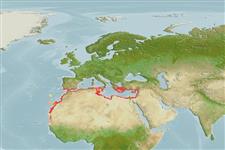Common names from other countries
Elasmobranchii (hajar och rockor) (sharks and rays) >
Myliobatiformes (Stingrays) >
Rhinopteridae (Cownose rays)
Etymology: Rhinoptera: Greek, rhinos = nose + Greek,pteron = fin, wing (Ref. 45335).
Issue
Considered valid in McEachran and Seret 1990 (Ref. 4441) but with a note that more recent authors consider it to be immature stages of R. marginata. Further study is needed to clarify problem (Ref. 4441). Tentatively valid in Last et al., 2016, for these differ subltly in their morphology (Ref. 114953:719).
Environment: milieu / climate zone / depth range / distribution range
Ekologi
marina bentopelagisk. Subtropical; 38°N - 15°N, 18°W - 36°E
Eastern Atlantic: southern Spain to Senegal, including the Mediterranean.
Size / Vikt / Age
Maturity: Lm ? range ? - ? cm
Max length : 200 cm WD hane/ej könsbestämd; (Ref. 6678)
Found in tropical to warm temperate coastal waters, but absent from islands of western Pacific. Often forming large groups swimming near the surface and quite destructive of commercial oyster and clam beds. Feeds on bottom-living mollusks, crustaceans and fishes. Seldom marketed. Ovoviviparous, gestation period up to one year with 2-6 embryos produced.
Life cycle and mating behavior
Maturities | Reproduktion | Spawnings | Egg(s) | Fecundities | Larver
Exhibit ovoviparity (aplacental viviparity), with embryos feeding initially on yolk, then receiving additional nourishment from the mother by indirect absorption of uterine fluid enriched with mucus, fat or protein through specialised structures (Ref. 50449).
McEachran, J.D. and B. Séret, 1990. Rhinopteridae. p. 71-72. In J.C. Quero, J.C. Hureau, C. Karrer, A. Post and L. Saldanha (eds.) Check-list of the fishes of the eastern tropical Atlantic (CLOFETA). JNICT, Lisbon; SEI, Paris; and UNESCO, Paris. Vol. 1. (Ref. 4441)
IUCN Red List Status (Ref. 130435)
Warning: mysqli::__construct(): (HY000/1040): Too many connections in /var/www/html/includes/func_getlabel.php on line 46
Can't connect to MySQL database (fbapp). Errorcode: Too many connections
